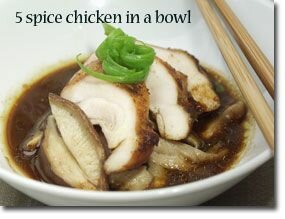healthy food tip and recipe
Today's Recipe
If you don't know what to serve for dinner tonight ...
The unique use of spices in the broth combined with the chicken gives you a great combination of flavors in this easy-to-prepare addition to your Healthiest Way of Eating. Enjoy!

Ingredients:
- 2 boneless, skinless chicken breasts (6 oz each), cut in 2-inch pieces
- 4 cups chicken broth
- 1/2 inch sliced fresh ginger, sliced (or 1/2 tsp dried ginger)
- 6 whole cloves
- 2 cinnamon sticks
- 5 star anise
- 1/2 tsp dried fennel seeds
- 1 medium-sized onion, chopped in big pieces
- 3 cloves garlic, chopped in big pieces
- 6 whole medium dried shiitake mushrooms
- 1 lb green beans, ends cut off
- 1/2 cup minced scallions
- Chop onion and garlic and let sit for 5 minutes to bring out their hidden health-promoting benefits.
- Healthy Sauté onion in a medium saucepan over medium-low heat for about 5 minutes, stirring frequently. Add garlic and continue to sauté for another minute. Add chicken broth, ginger, cloves, cinnamon stick, star anise, fennel seeds, and shiitake mushrooms. Turn heat to medium and simmer for 15 minutes.
- While broth is simmering, cut ends off beans and cut into 1-inch pieces.
- Strain broth mixture (saving shiitake mushrooms) and put liquid back into pan. Bring to a boil, add chicken pieces and green beans, and cook on medium heat for 7-10 minutes. You may need to skim the surface a little while chicken pieces are cooking. Slice shiitake mushrooms and add to chicken and broth. Add scallion as well as salt and pepper to taste.
- Napa Cabbage Salad
In-Depth Nutritional Profile for 5-Spice Chicken in a Bowl
Healthy Food Tip
What is the best way to select poultry and meat?
When selecting any type of meat we should try and meet two broad health goals. First, we should be trying to select meats that are high-quality and not contaminated with residues of hormones, antibiotics, and other health-compromising substances. Second, we should be choosing meats that are not high in total fat or saturated fat.
Luckily, when it comes to that first goal of high-quality meat, the national organics law does a good job of protecting us. The quality of animal foods can be more difficult to assure than the quality of plant foods since animals (compared to plants) eat relatively large amounts of food and live for relatively long periods of time before slaughter. For this reason, environmental contaminants can be more readily stored and concentrated in meat through a process called biomagnification. This makes the selection of high-quality meat products especially important.
Organically certified beef and chicken protect you in a fundamental way from many contaminants potentially found in these animal foods. Organic also guarantees animal husbandry that has not relied on routine use of growth hormones or antibiotics to keep the animals healthy. While organic does not always guarantee that the animals were grass-fed or range-fed, many organic producers also use these practices (indicated on their labels as "grass-fed" or "range-fed" or "free ranging"). Certified organic chicken and beef obtained from range-fed animals gives you the best chance to obtain extremely high quality products.
We're still left with the question of fat content, however. Organically raised, grass-fed or range-fed animals can still be slaughtered and packaged into products that are high in total fat or saturated fat. In order to make sure that you're selecting lower fat products, I strongly recommend that you consider the cut of meat involved. Cows use their hind legs as their primary source of locomotion, and for this reason, cuts of beef from the back legs are the lowest in fat and highest in muscle protein. Therefore, if you select cuts from the back leg bone (called the round bone) you will be getting cuts with the least amount of fat. My top recommendation here is eye of round, followed by top round, and then bottom round. These cuts of steak can also be handed back to the butcher in your supermarket for grinding into ground beef. They are almost always lower in fat than the ground beef sitting in the meat section, since that ground beef has seldom been cut from the round.
W ith poultry, the equivalent low-fat area is the breast. Therefore my recommended cuts for both turkey and chicken are the breast sections. Ordinarily, I would also recommend that you purchase skinned chicken or turkey breast since the skin contains a substantial amount of fat. However, in this case, I recommend that you purchase chicken and turkey breast with the skin still on. I'm making this recommendation in order for you to cook the breast with the skin on, which helps retain its moisture; the skin is removed once it has been cooked. Based on the research in this area, I am confident that you will not be consuming a problematically higher amount of fat by waiting to skin your poultry after cooking. But you will end up with a more spectacular meal!
Remember that these two health goals go hand-in-hand. Certified organic and grass-fed or range-fed chickens and cows will give you the high quality that you are looking for. Selecting certain cuts from each type of meat will give you amounts of total fat and saturated fat that can usually be integrated into a Healthiest Way of Eating.




No comments:
Post a Comment